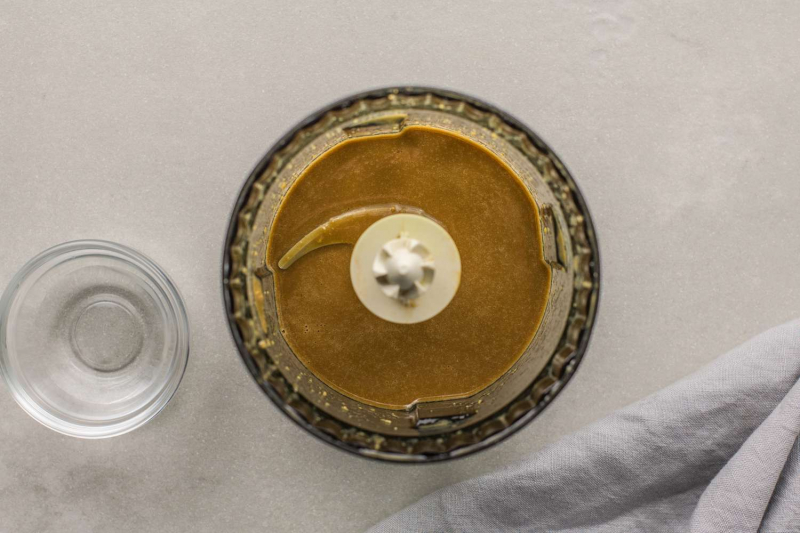Prep: 5 mins
Cook: 0 mins
Total: 5 mins
Servings: 8 servings
This Japanese-inspired miso and ginger salad dressing has a perky, gingery flavor featuring salty and sweet notes from a combination of rice vinegar, soy sauce, miso, and sesame oil. Unlike store-bought dressings, this one low in sugar and has only sesame oil as the added fat. Making your own dressing at home guarantees that there are no additives, preservatives, or empty calories from hydrogenated oils, and that all ingredients are fresh—not to mention all the money you’ll be saving. Besides, you can make this dressing in just five minutes and double the measurements and keep it in the fridge for up to a week.
Use it on fresh lettuce and endive salads, on spring and summer rolls, or as a marinade for chicken or fish. Mix it with pasta or potato salads for a surprising summer side dish, use it as a dressing for coleslaw, or drizzle it on ham and cheese open-faced ham and cheese sandwiches for a tangy twist on otherwise earthy flavors.
This dressing is naturally gluten free, but double-check your soy sauce and miso labels, as many brands do have wheat-based ingredients that act as thickeners. To be sure, use tamari instead of soy sauce if there are any gluten allergies in the house.
Ingredients
-
1/4 cup miso
-
2 tablespoons rice vinegar
-
2 tablespoons soy sauce
-
2 tablespoons sesame oil
-
1 teaspoon fresh ginger, minced; or 1 teaspoon ginger powder
-
Water, or soy sauce, as needed, optional
Steps to Make It
-
Gather the ingredients.

-
Combine all ingredients in the vase of a blender or food processor. Process at high speed for a few seconds until all ingredients are well combined. If mixing by hand, use a fork or whisk and beat until smooth. Alternatively, place all ingredients in a Mason jar, cover, and shake until fully emulsified.

-
Add a bit of water, a teaspoon at a time, if desired, for a thinner consistency. Serve as a dressing or dipping sauce.

-
Enjoy.
Thicker Dipping Sauce
This vegan miso salad dressing can also be a great spring roll dipping sauce when skipping the water altogether. Simply mix the ingredients and check for consistency. If you want it thicker, replace a tablespoon of sesame oil with 1 tablespoon of tahini. This thicker version makes for a great dressing for grilled tempeh, seitan, or tofu steaks.
For another variation, try thinning out this miso dressing with orange juice instead of water. Use the citrusy version on grilled cauliflower steaks, chicken satays, or as a dressing for rice, quinoa, or farro salads.
Toning Down the Miso Flavor
If you're not used to miso, it's possible that you may find its flavor a bit too strong or too salty. So here are a few ideas on how to tone down the miso flavor:
- Dilute this dressing by adding water as needed or sesame or olive oil. If you choose other oils for dilution, go for mild-flavored ones that won't overpower the miso taste, like canola or safflower.
- Using soy milk will add creaminess while cutting the strong miso flavor. Unsweetened cashew, rice, oat, or hazelnut beverages also add great texture and help dilute the miso flavor.
What Is Miso Paste?
Miso paste comes from fermented soybeans, grains, and koji, an edible fungus also used in making beverages like sake. Many miso brands ferment their paste with gluten-containing grains, but many others use only gluten-free grains, in their process.
Miso paste can be fermented for a few weeks to a few years, and it's from the fermentation time that it derives its flavor, aroma, and color. White is the sweeter miso paste, red is the strongest and more pungent, and yellow is an in-between of sweetness and umami power. If you're new to miso, start with white paste to get acquainted with its flavor and limitless possibilities in the kitchen. When you feel ready to experiment some more, buy some yellow or red.
Although relatively high in sodium—a 17 grams serving has 634 milligrams of sodium, close to 27 percent of the recommended daily intake of the mineral—miso is known for its health-promoting properties, particularly its probiotic content, a product of the fermentation process.
| Nutrition Facts | |
|---|---|
| Servings: 8 | |
| Amount per serving | |
| Calories | 50 |
| % Daily Value* | |
| Total Fat 4g | 5% |
| Saturated Fat 1g | 3% |
| Cholesterol 0mg | 0% |
| Sodium 539mg | 23% |
| Total Carbohydrate 2g | 1% |
| Dietary Fiber 1g | 2% |
| Total Sugars 1g | |
| Protein 1g | |
| Vitamin C 0mg | 0% |
| Calcium 6mg | 0% |
| Iron 0mg | 2% |
| Potassium 37mg | 1% |
| *The % Daily Value (DV) tells you how much a nutrient in a food serving contributes to a daily diet. 2,000 calories a day is used for general nutrition advice. | |
